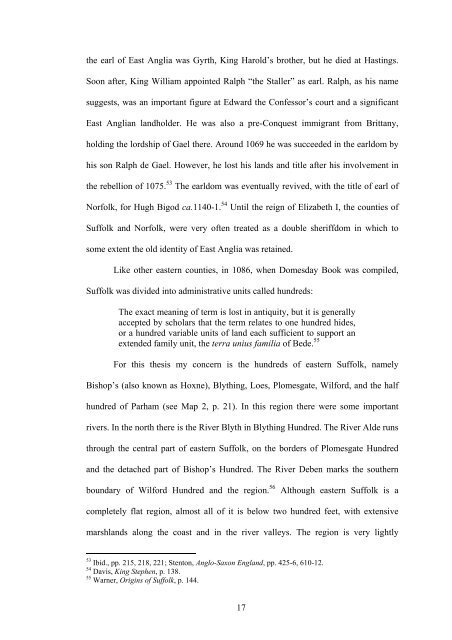I certify that I have read this thesis and have ... - Bilkent University
I certify that I have read this thesis and have ... - Bilkent University
I certify that I have read this thesis and have ... - Bilkent University
You also want an ePaper? Increase the reach of your titles
YUMPU automatically turns print PDFs into web optimized ePapers that Google loves.
the earl of East Anglia was Gyrth, King Harold’s brother, but he died at Hastings.<br />
Soon after, King William appointed Ralph “the Staller” as earl. Ralph, as his name<br />
suggests, was an important figure at Edward the Confessor’s court <strong>and</strong> a significant<br />
East Anglian l<strong>and</strong>holder. He was also a pre-Conquest immigrant from Brittany,<br />
holding the lordship of Gael there. Around 1069 he was succeeded in the earldom by<br />
his son Ralph de Gael. However, he lost his l<strong>and</strong>s <strong>and</strong> title after his involvement in<br />
the rebellion of 1075. 53 The earldom was eventually revived, with the title of earl of<br />
Norfolk, for Hugh Bigod ca.1140-1. 54 Until the reign of Elizabeth I, the counties of<br />
Suffolk <strong>and</strong> Norfolk, were very often treated as a double sheriffdom in which to<br />
some extent the old identity of East Anglia was retained.<br />
Like other eastern counties, in 1086, when Domesday Book was compiled,<br />
Suffolk was divided into administrative units called hundreds:<br />
The exact meaning of term is lost in antiquity, but it is generally<br />
accepted by scholars <strong>that</strong> the term relates to one hundred hides,<br />
or a hundred variable units of l<strong>and</strong> each sufficient to support an<br />
extended family unit, the terra unius familia of Bede. 55<br />
For <strong>this</strong> <strong>thesis</strong> my concern is the hundreds of eastern Suffolk, namely<br />
Bishop’s (also known as Hoxne), Blything, Loes, Plomesgate, Wilford, <strong>and</strong> the half<br />
hundred of Parham (see Map 2, p. 21). In <strong>this</strong> region there were some important<br />
rivers. In the north there is the River Blyth in Blything Hundred. The River Alde runs<br />
through the central part of eastern Suffolk, on the borders of Plomesgate Hundred<br />
<strong>and</strong> the detached part of Bishop’s Hundred. The River Deben marks the southern<br />
boundary of Wilford Hundred <strong>and</strong> the region. 56 Although eastern Suffolk is a<br />
completely flat region, almost all of it is below two hundred feet, with extensive<br />
marshl<strong>and</strong>s along the coast <strong>and</strong> in the river valleys. The region is very lightly<br />
53<br />
Ibid., pp. 215, 218, 221; Stenton, Anglo-Saxon Engl<strong>and</strong>, pp. 425-6, 610-12.<br />
54<br />
Davis, King Stephen, p. 138.<br />
55<br />
Warner, Origins of Suffolk, p. 144.<br />
17
















